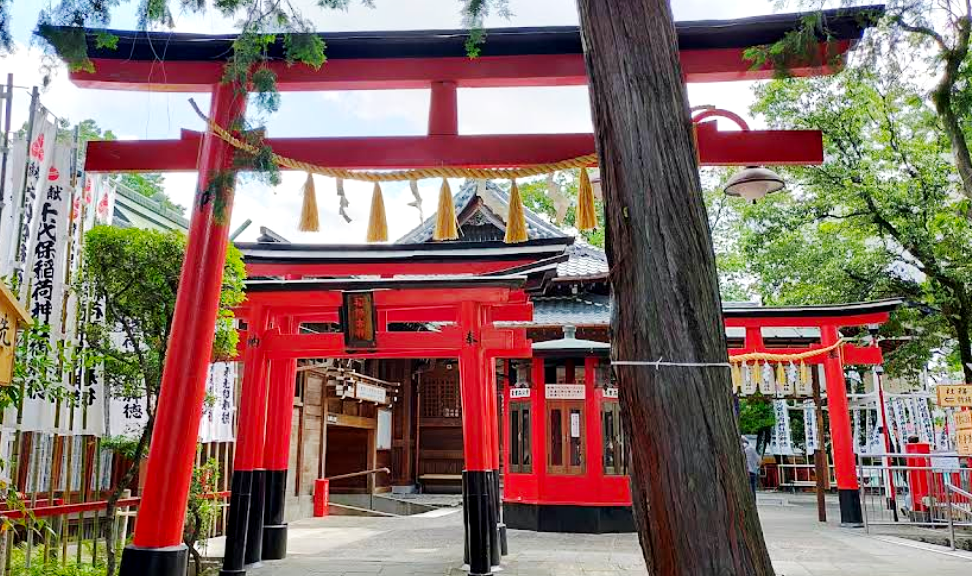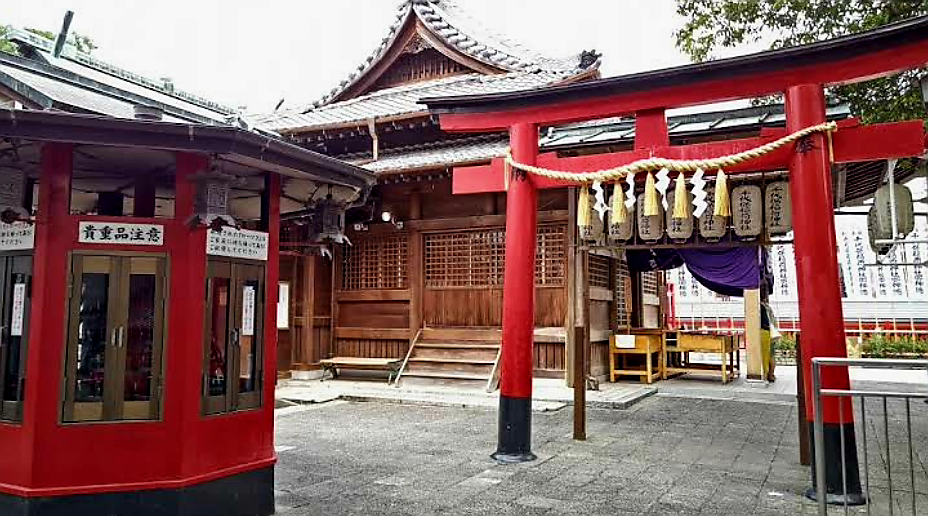There are places in Japan that feel hidden yet deeply alive — places where tradition quietly breathes through lantern light and laughter.
For me, one of those places is Chiyoho Inari Shrine, affectionately called Ochobo-san (おちょぼさん) by locals.
Nestled in Kaizu City, Gifu Prefecture, this small countryside shrine draws more than two million visitors a year, each coming to give thanks, pray for good fortune, or simply stroll through its lively market street.
I first heard about Ochobo-san as a “shrine of business success,” but standing before its bright red torii gates on a chilly evening, I realized it’s much more — a place that blends ancient faith, rural warmth, and everyday joy.
A Shrine With a Thousand-Year Story
The history of Chiyoho Inari Shrine stretches back about 1,000 years to the Heian period.
According to records, Yoshitaka, the sixth son of Hachiman Tarō Minamoto no Yoshiie, branched from his family, taking the surname Mori. He was entrusted with his ancestor’s sacred seal, sword, and portrait — treasures meant to be protected through generations.
Centuries later, during the Bunmei era (around 550 years ago), Yoshitaka’s descendant Mori Hachikai cultivated the local village and enshrined that same sacred seal. This act marked the birth of the shrine.
Its name, Chiyoho, means “to preserve for a thousand generations,” symbolizing the wish that divine protection continues endlessly.
Today, the shrine enshrines three deities — Ōmioya no Ōkami, Inari no Ōkami, and Mioya no Kami — and remains beloved as Ochobo-san, one of Japan’s three major Inari shrines, along with Kyoto’s Fushimi Inari Taisha and Toyokawa Inari in Aichi.

The Spirit of Prayer
At Ochobo-san, prayer follows Shinto tradition. A priest recites words of gratitude and protection on behalf of worshippers, offering thanks for daily blessings and asking for continued prosperity and safety.
The main shrine, built in wood with graceful curves and gold details, stands as the heart of the grounds. It’s said that praying here brings good fortune in business prosperity and household safety — two pillars of a peaceful life in Japan.
Nearby, the worship hall welcomes individual visitors. You can place offerings — usually a candle, sacred sake, or aburaage (fried tofu) — on the table, then bow and pray. This simple act connects the modern world with traditions that have lasted centuries.
The Unique Offering Ritual
Ochobo-san has a special custom you won’t find at other shrines.
Before approaching the main hall, visitors stop at small shops near the entrance to purchase two things:
a candle and a piece of fried bean curd (aburaage) tied with straw (cost very cheap).
It’s believed that the fox deity, messenger of Inari, loves fried tofu. So, the ritual goes like this:
- Light the candle at the communal stand to express gratitude.
- Offer coins and place the tofu on the tray at the worship hall.
- Bow twice, clap twice, bow once — the rhythm of Shinto prayer.
Watching locals repeat this with calm familiarity is moving. The gesture is humble but heartfelt — one candle, one tofu, one quiet wish for luck in work, life, or family.
The Night of Tsukikoshi: A Month-End Tradition
If you visit on the last night of any month, you’ll witness Tsukikoshi Mairi (月越参り) — literally “crossing into the next month.”
From the final evening to the dawn of the new month, worshippers come to thank the gods for the blessings of the past month and pray for success in the next.
During this time, the lattice doors of the worship hall stay open, and the shrine is beautifully lit. Stalls selling candles, talismans, and food line the approach, creating an almost festival-like atmosphere.
Even past midnight, families, business owners, and groups of friends can be seen making their offerings. The sound of clapping, laughter, and rustling paper fortunes fills the air.
It’s a deeply local custom — half spiritual, half social — showing how faith and community intertwine in rural Japan.
Inside the Grounds
Though modest in size, the shrine complex holds surprising depth.
- Main Hall (Honden): Enshrines Ōmioya no Ōkami, Inari no Ōkami, and Mioya no Kami.
- Mausoleum: Houses old stone fox statues and honors Ukemochi no Kami, deity of food and nourishment.
- Old Hall: A preserved part of the original main hall, containing a talisman from Tada Shrine, where the spirits of the Genji clan are worshipped.
- Spirit Hall: Enshrines about 120 followers who supported the shrine through the Shōwa period.
- Shrine Office: Built in 1953, it’s a grand wooden structure connecting to the main hall. Here you can apply for prayers or rest in the waiting room.
- Onko Shūseikan Museum: Displays shrine treasures and artwork — admission is free.
Each corner feels steeped in memory, reminding visitors that this is not just a place of wish-making but of gratitude and history.
The Marketplace: Faith and Fun
One of Ochobo-san’s charms is its 700-meter approach, lined with about 120 food and souvenir stalls.
Here, faith meets flavor. Visitors pray first, then eat, chat, and shop — turning a spiritual outing into a joyful day trip.
You can find colorful fugashi sweets, pickled daikon glowing yellow with turmeric, dried shiitake mushrooms, and beans from the local Mamekichi Honpo shop.
Many stalls sell freshly grilled skewers, croquettes, and steaming bowls of oden.
It’s the kind of lively scene that makes small-town Japan so special — locals calling out greetings, families sharing snacks, and visitors leaving with both a full heart and a full stomach.
How to Visit
- Location: Kaizu City, Gifu Prefecture (海津市平田町).
- Access: About 30 minutes by car from Ogaki or 20 minutes from Hashima. Parking is available but often paid. Cycling from Ogaki is possible but long.
- Best Time: Evening visits during Tsukikoshi Mairi (the month-end) for the most atmosphere.
- Admission: Free; museum entry also free.
- Tips: Bring small coins for offerings; wear comfortable shoes — the approach is long and lively!
- Parking: Is around 400 to 500 yen. (It gets filled up during peak times)
Visiting Ochobo-san felt different from larger shrines in Kyoto or Tokyo.
It wasn’t about grandeur — it was about connection. People came not only to pray but to be part of something continuous: gratitude, community, and hope.
As the candlelight flickered beside the fox statues, I placed my own small piece of fried tofu and whispered thanks — for work, health, and the simple joy of living here in Japan.
When I left the shrine, the marketplace was still glowing softly under the night sky. Somewhere behind me, someone clapped twice, and I could almost feel their wish travel upward — mingling with mine.
If you love quiet cultural trips, Ochobo-san makes a perfect evening or weekend visit from Gifu or Ogaki.
Come with a small wish in your heart, light a candle, offer the tofu, and enjoy the food stalls after.
It’s one of those places that reminds you: faith doesn’t have to be solemn — sometimes, it’s shared with laughter, warmth, and the smell of grilled snacks in the air.

